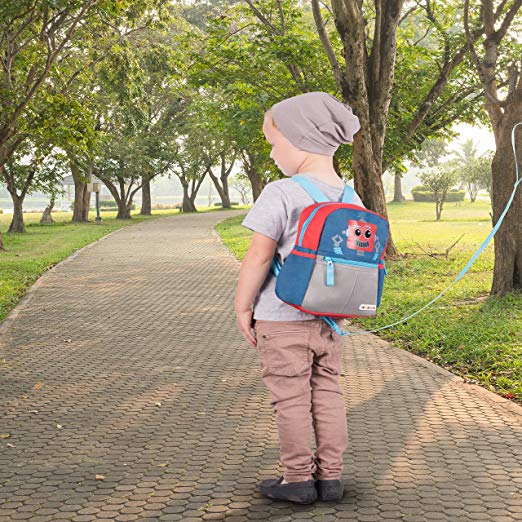Autism Safety: 10 Tips to Protect Your Child
As parents, it’s our duty and responsibility to keep our children safe.
- We babyproof our homes
- Teach stranger danger
- Use car seats or booster seats in the car
- Helmets and knee pads for bike safety
- We lock cabinets and gate stairs
it’s an endless list. But if your child is autistic there may be additional safety measures you need to take.
Autism Safety: 10 Tips to Protect Your Child
Autistic children don’t always have a clear sense of danger, and may not be able to cooperate when they need help. This can put them at risk for some particularly vulnerable situations making autism safety crucial.
Additionally, if a stressful situation triggers your child’s fight or flight instinct, they could run into danger becoming lost or disoriented. Children running like this is referred to as elopement or flight risk.
Disclaimer: This post contains affiliate links.
Major Autism Safety Concerns
Unfortunately, we can’t be with our kids all the time. But we want to keep our kids safe whether we are there or not.
Two of the biggest autism safety concerns for parents with autistic children are wandering (eloping), and abuse.
How Common Is Elopement in Autism?
Parents need to be on guard because the truth is, it’s extremely common (and dangerous) for autistic children to be a flight risk.
A study in the journal Pediatrics published staggering statistics about elopement in children on the autism spectrum.
- 49% of parents reported their child wandered away at least once (compared to 11% of parents with neurotypical children).
- 53% of these children were missing long enough to cause their parents’ significant worry.
- 65% of the incidents involved a close call with traffic.
- 24% of incidents involved a close call with drowning.
- 43% of parents reported that their child was a significant enough flight risk that it interferes with their ability to sleep at night.
How Common Is Abuse?
- 47% of parents reported that their children had been hit by peers
- 65% of parents reported that their children with ASD had been victimized by peers in some way within the past year
- 50% reported them to be scared by their peers
- 12% indicated their child had never been invited to a birthday party
- 6% were almost always picked last for teams
- 3% ate alone at lunch every day
- One in three children with an identified disability for which they receive special education services are victims of some type of maltreatment by their caregivers (i.e., either neglect, physical abuse, or sexual abuse by caregivers)
I’ve tried to write this post four other times, and every time I start looking at these statistics I stop because they’re so scary.
I’m not putting them out there because I want to scare other parents. My goal is to raise awareness of these risks so parents can protect their children.
After reading the tragic story about Maddox Ritch in the news this week, I knew it was time to get this post out there for other parents.
Educating Autistic Children about Safety
It’s important to teach your child how to be safe and about the risks of different situations. The more awareness they have about possible dangers around them, the better chance they will make safe choices on their own.
However, as critical as education is, it doesn’t guarantee the safety of your child, so using other strategies are important too.
You can educate your child on safety in different ways, including play-based learning activities or social stories.
Smarter than the Scoopers
Read the story Smarter than the Scoopers with your child is an excellent way to introduce them to various safety concepts.
The entire story is about empowering children with the right skills to make safe choices.
SCOOP is an acronym to help children remember five personal safety strategies to keep them safe in everyday situations: be Smart, use your Call list, zerO talking to strangers, keep strangers Out of your personal space, and always Pair up.
Autism Safety Precautions

There are two main types of safety precautions you should take to protect your child from wandering and abuse – prevention and responding.
The level of additional safety measures you decide to have in place for your child with autism should be based on the level of risk. I’m going to cover several possible safety measures for prevention and readiness.
It’s up to you to assess the level of risk and choose what measures will work best for you and your family.
Prevention Strategies
Prevention strategies are those that reduce or eliminate the likelihood of a dangerous event from occurring.
Window locks and door alarms
You don’t need to invest a ton of money into a home security system to set up alarms or locks. In fact, it’s less than $20 to get two of the top-rated door alarms on Amazon.
You don’t need screws or wiring to install. These alarms are battery operated and will sound at 130
They can also be installed on your child’s bedroom door. If your child leaves their room at night while you’re sleeping they could encounter safety hazards within your home, even if they don’t get outside.
You can also use adjustable window locks to secure the windows in
Visual Warnings
Set up visuals in your home where ever necessary.
This might include a visual reminder to turn an appliance off, stop signs by the main doors or “do not enter” signs on hazardous rooms, such as the room where the furnace or hot water heater is located
Related: 160 Visuals for PECS and Daily Routines
Harnesses or Wrist Links
To prevent your child from bolting in public, especially in crowded or unfamiliar places, consider using a harness or wrist link.
The Anti Lost Wrist Link goes around your wrist and your child’s. The connecting cord stretches to give your child about 8 feet of space so it’s less restrictive than holding hands but still keeps your child close by.
Another popular choice if your child is a flight risk is a backpack harness and leash combo.
Swimming Lessons
91% of accidental deaths in autistic children under the age of 14 are a result of accidental drownings.
Most of the time this occurs when a child has wandered and doesn’t understand the safety risks of water.
Being able to swim could be the difference between life and death. Although it usually takes kids with ASD longer to learn how to swim, it’s an important skill to have.
Many community pools and YMCA locations offer special programs for individuals with special needs like autism. Often, these programs provide your child with 1:1 instruction, rather than a group. These programs are usually offered at low or no cost.
Take some time to check with local pools and community centers near you to find the best program for your child. Google “Special Needs Swimming Lessons in (Your city).
Angelsense GPS
Angelsense GPS is a location tracking and voice monitoring device specifically designed for children with special needs. It’s basically the holy grail of safety devices for when you aren’t able to be directly with your child.
In my opinion, if you’re looking for the best GPS tracker for kids – this is it.
Some features of Angelsense GPS:
- Real-time location tracking – the GPS location updates every 30 seconds so you can accurately locate your child instantly.
- Unknown location text alerts – So, if your child goes somewhere they haven’t been to before you will automatically receive a notification via text message.
- Listen in feature – You can listen in on your child to get an idea of what’s happening around them at any time. This feature can help parents determine if their children are being mistreated by their peers or caregivers. You may have read this recent news article about what a mom overheard inside a special ed classroom in West Virginia.
- Two way talking – You can speak to your child automatically through the Angelsense GPS device without relying on your child answering a phone call.
Angelsense devices come with a charger, case, a special key (so only parents/key holders can remove the device) a sleeve and three fasteners.
The number of people who can download the app to monitor your child is unlimited and their month to month plan has no contract so you can cancel anytime.
Responding: Emergency Readiness Strategies
Emergency readiness strategies are strategies that will help you respond as fast as possible if your child ever does go missing or is hurt.
The Big Red Safety Box
The Big Red Safety Box is a free resource provided by the National Autism Association which contains many wonderful safety items, including:
- Be Red-y safety book
- 2 GE Wireless Door/Window Alarms with batteries
- 1 Road ID Personalized, Engraved Shoe ID Tag
- 5 Adhesive Stop Sign Visual Prompts for doors and windows
- 2 Safety Alert Window Clings for car or home windows
- 1 Red Safety Alert Wristband
- 1 Child ID Kit from the National Center for Missing and Exploited Children
You can also download the PDF
- Caregiver Checklist
- Swimming Lessons Tool
- Root-cause Scenario & Strategies Tool
- Stop Sign Prompts
- Social Story: “Staying in my house”
- Sample IEP Letter (Never allow restraint/seclusion practices into any IEP as this increases associated risks.)
- Sample Physician’s Letter
- General Awareness Letter: share with schools, homeowner’s association, law enforcement agencies, physicians, etc.
- Five Affordable Safety Tools
- Caregiver Resources One-sheeter
- Family Wandering Emergency Plan
- First-responder Alert Form (Please fill out and provide a copy to your local law enforcement agencies.)
- Calming Cards Sheet
- Student Profile Sheet
- Wandering-prevention One-Sheeter
Keep a Fully Stocked First Aid Kit
As a best practice, keep a first aid kit in your home and another in your car. You should be able to access your first aid kit quickly if anyone is injured. You should have a first aid kit in both your home and your car so you can use first aid as quickly as possible should your child (or anyone else) get injured.
Ready to use kits are available on Amazon.
It’s a good idea to keep a small note pad and pen inside your first aid kit so you can make note of anything that you use from the kit. Use that notebook to regularly restock your kit so you always have everything you need.
Family Wandering Emergency Plan and First-Responder Alert Form
Templates for both of these are included in the NAA’s free handbook for autism safety which is why I highly recommend downloading this safety resource.
The emergency plan outlines the steps to take in an emergency event. It also outlines critical details about your child to help identify them, common locations they may go, nearby bodies of water, favorite items, etc.
Law enforcement will use this information if they ever need to search for your child. Having this form filled out significantly reduces the amount of time they must spend interviewing family – which means they have more time for finding and bringing home your child safely.
Favorite items are important because children with autism won’t always respond to someone calling their name, especially a stranger.
So, search and rescue crews try to use missing children’s interests to lure them out if they’re hiding somewhere.
Identification Wristbands
If your child is not able to communicate their name and address on their own, consider purchasing a custom engraved identification wristband.
You can include information like name, emergency phone numbers, medical conditions, etc. So if your child does wander and someone finds them, they can quickly identify your child and help.
Remember
None of these strategies should be a substitution for proper adult supervision. These resources are extra measures to help keep your child




